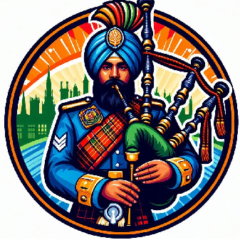Mastering the Bagpipes: A Comprehensive Guide to Learning with Notation
Ever heard the haunting wail of bagpipes echoing across a misty Scottish glen and thought, “I want to play that”? You’re not alone. The Great Highland Bagpipe, with its bold, soul-stirring sound, has captivated hearts for centuries. But learning to play it?
That’s a journey that feels like climbing a mountain—daunting yet exhilarating. A full bagpipe course with notation is your map to the summit, blending step-by-step instruction with the magic of written music to guide you. Let’s dive into how you can master this iconic instrument, one note at a time, and why notation is your secret weapon.
Full Bagpipe Course with Notation
Why Learn the Bagpipes?
The Allure of the Great Highland Bagpipe : Full Bagpipe Course with Notation
There’s something primal about the bagpipes. Their sound is like a call from the past, stirring emotions with every drone and melody. Whether it’s the triumphant march of “Scotland the Brave” or the mournful lilt of a slow air, the bagpipe’s voice is unmistakable. Learning to play connects you to a rich cultural heritage, from Scottish clans to modern pipe bands. It’s not just an instrument—it’s a storytelling tool that lets you express joy, sorrow, and everything in between.
Full Bagpipe Course with Notation: Benefits of Learning with Musical Notation
Why bother with notation? Think of it as your musical GPS. Bagpipe notation, with its unique symbols and structure, helps you visualize the melody and embellishments, making complex tunes easier to grasp. It’s like having a recipe for your favorite dish—you could wing it, but following the steps ensures perfection. Notation also standardizes your learning, so you can share tunes with pipers worldwide or even join a band. Plus, it sharpens your music-reading skills, opening doors to other instruments.
What is a Full Bagpipe Course with Notation?
Core Components of a Complete Full Bagpipe Course with Notation
A full bagpipe course is like a well-packed backpack for your musical adventure. It covers everything from holding a practice chanter to playing full tunes on the bagpipes. Expect lessons on finger techniques, music theory, embellishments like taorluaths, and even instrument maintenance. The best courses blend video tutorials, live feedback, and downloadable resources to keep you engaged. Whether you’re a beginner or aiming for advanced piobaireachd, a comprehensive course builds your skills systematically.
Full Bagpipe Course with Notation: The Role of Notation in Bagpipe Mastery
Notation is the backbone of any serious bagpipe course. Unlike other instruments, bagpipes use a specific notation style that captures their unique nine-note scale and intricate grace notes.
It’s like learning a new language, but once you crack the code, you can play any tune with precision. Courses that emphasize notation teach you to read and write music, ensuring you’re not just mimicking sounds but truly understanding the structure of each piece.
Full Bagpipe Course with Notation: Getting Started with the Practice Chanter
Choosing the Right Practice Chanter
Before you blow into a full set of pipes, you’ll start with a practice chanter—a smaller, quieter instrument that’s like the bagpipe’s training wheels. It’s affordable (around $40-$100) and essential for mastering fingerwork.
Look for a chanter made of durable materials like polypenco, and check for a clear, consistent tone. Online courses often include tips on picking the right one, so you don’t end up with a dud.
Full Bagpipe Course with Notation: Basic Finger Techniques for Beginners:
Got your chanter? Great! Now, let’s get those fingers moving. The practice chanter teaches you the nine notes of the bagpipe scale, from low G to high A. Start with simple exercises to build muscle memory—think of it as learning to type on a keyboard.
Keep your fingers relaxed but precise, and avoid “false fingerings” (when you accidentally hit the wrong note). A good course will guide you through these basics with clear demonstrations, setting you up for success.
Understanding Bagpipe Notation
Full Bagpipe Course with Notation: The Unique Scale of the Bagpipe
Bagpipes don’t play like a piano or guitar. Their scale is a mixolydian mode, centered around A, with a flatted seventh for that distinctive sound. Imagine it as a musical signature that screams “bagpipes!” Notation reflects this, using a simplified staff that omits accidentals since the pipes can’t play sharps or flats. Understanding this scale is key to reading sheet music and nailing the bagpipe’s unique vibe.
Full Bagpipe Course with Notation: Reading and Interpreting Bagpipe Sheet Music
Bagpipe notation looks intimidating at first—grace notes and embellishments clutter the page like musical confetti. But don’t worry; it’s simpler than it seems. Each note is written on a standard staff, with grace notes (like G or D) shown as smaller symbols. Courses often include downloadable PDFs with expanded notation, breaking down each tune phrase by phrase. With practice, you’ll read sheet music as easily as a bedtime story.
Building a Strong Foundation
Mastering the Nine Notes
The bagpipe’s nine notes are your building blocks. A good course starts with exercises to play each note cleanly, from low G to high A. It’s like learning the alphabet before writing a novel. Video lessons, like those from BagpipeLessons.com, often demonstrate transitions between notes to avoid “crossing noises” (those awkward squeaks when your fingers fumble). Practice these daily, and you’ll be ready for full tunes in no time.
Full Bagpipe Course with Notation: Timing and Rhythm with a Metronome
Bagpipes are as much about rhythm as melody. A metronome is your best friend here, keeping your timing as steady as a Highland march. Set it to a comfortable 60 beats per minute and practice playing each note on the beat. This builds muscle memory and ensures your tunes sound crisp, not sloppy. Courses like Highland Pipe Academy emphasize metronome practice to make your playing polished and professional.
Essential Bagpipe Techniques
Grace Notes and Embellishments
Grace notes are the bagpipe’s secret sauce, adding flair to every tune. Think of them as musical spices—too little, and the tune’s bland; too much, and it’s overwhelming. Techniques like taorluaths and doublings require precise fingerwork, and notation helps you see exactly where they fit. Courses break these down into bite-sized lessons, often with video demos to show you the ropes.
Developing Proper Airflow and Grip
Playing bagpipes is a full-body workout. You need steady airflow to keep the drones humming and a firm yet relaxed grip on the chanter. It’s like balancing a yoga pose while singing—tricky but doable with practice. Courses teach you to control your breathing and maintain bag pressure, ensuring your pipes sing rather than squeal. Notation guides your timing, so your airflow syncs perfectly with each note.
Transitioning to the Full Bagpipes
From Practice Chanter to Full Pipes
After months on the practice chanter (typically 3-12, depending on your pace), you’re ready for the big leagues: the full bagpipes. This transition is like upgrading from a bicycle to a motorcycle—thrilling but intense. Courses like Bagpipe Master guide you through selecting a quality set of pipes and transferring your chanter skills. Expect a learning curve as you juggle blowing, squeezing, and fingering all at once.
Tuning Your Bagpipes for Optimal Sound
An out-of-tune bagpipe is like nails on a chalkboard. Tuning involves adjusting the drones and chanter to harmonize perfectly. Online courses, like those at Highland Pipe Academy, offer step-by-step videos on tuning techniques, from tweaking reeds to balancing drone pitch. Notation helps here too, ensuring your tunes sound as intended when played in tune. A well-tuned pipe is your ticket to sounding like a pro.
Learning Iconic Bagpipe Tunes
Beginner-Friendly Tunes to Start With
Ready to play something recognizable? Start with classics like “Scots Wha Hae” or “Amazing Grace.” These tunes are simple yet powerful, perfect for building confidence. Courses provide sheet music and video tutorials to break them down into manageable chunks. It’s like assembling a puzzle—one piece at a time until the whole picture emerges.
Using Notation to Learn Complex Melodies
As you progress, you’ll tackle more intricate tunes like “Highland Cathedral.” Notation is your guide, showing you exactly where to place grace notes and embellishments. Interactive platforms like Soundslice let you slow down sheet music and loop tricky sections, making complex melodies feel achievable. With notation, even advanced tunes become less daunting.
Online Bagpipe Courses with Notation
Top Platforms for Learning Bagpipes
The internet is a treasure trove for bagpipe learners. Platforms like BagpipeLessons.com, Dojo University, and Bagpipe Master offer comprehensive courses with notation-heavy resources. BagpipeLessons.com, for instance, provides downloadable PDFs and video lessons from award-winning piper Jori Chisholm. These platforms cater to all levels, ensuring you’re never stuck.
Benefits of Online Learning with Interactive Notation
Online courses are like having a master piper in your living room. They offer flexibility, letting you learn at your own pace, and interactive notation tools like Soundslice enhance the experience. You can zoom in on sheet music, adjust tempos, and even print your own scores. Plus, many platforms include community forums for feedback, making learning feel less lonely.
Practicing Effectively with Notation
Creating a Practice Schedule
Consistency is key, but who has hours to spare? A good course helps you craft a practice schedule—think 20-30 minutes daily, focusing on specific skills like grace notes or timing. Notation keeps you on track, letting you mark progress and revisit tricky sections. It’s like a workout plan for your fingers and lungs, building strength over time.
Using Technology to Enhance Learning
Modern tech makes practice fun. Apps like PipeScore let you write and edit bagpipe music, while metronome apps ensure perfect timing. Some courses integrate tools like Zoom for live feedback or apps for offline access. Notation software helps you create custom arrangements, turning you from a player into a composer.
Overcoming Common Challenges :
Avoiding False Fingerings
Ever hit a wrong note and cringed? False fingerings are a common newbie mistake, but notation helps you spot where your fingers should go. Courses teach you to watch for crossing noises and practice slow, deliberate movements. With time, your fingers will dance across the chanter like a Highland jig.
Building Confidence in Performance
Stage fright is real, but a solid grasp of notation gives you confidence. Knowing a tune inside out—thanks to sheet music—means you’re less likely to freeze mid-performance. Courses often include tips on performing, from small gatherings to competitions, so you can share your music with pride.
Joining the Bagpipe Community : Full Bagpipe Course with Notation
Connecting with Other Pipers
Bagpiping isn’t a solo sport. Online platforms like Dojo University offer forums and Facebook groups where you can swap tips, share videos, and get feedback. It’s like joining a clan of pipers who cheer you on. Connecting with others keeps you motivated and opens doors to new tunes and techniques.
Participating in Workshops and Competitions
Want to test your skills? Workshops, like those from Roddy the Piper, offer hands-on learning, while competitions let you shine. Notation ensures you’re playing standardized tunes, making it easier to compete or jam with others. These experiences are like fuel for your piping passion, pushing you to improve.
Advanced Techniques and Notation
Exploring Piobaireachd and Complex Tunes (Full Bagpipe Course with Notation)
Piobaireachd, the classical music of the bagpipes, is like the instrument’s soul. These intricate compositions demand precise notation to capture their depth. Advanced courses teach you to read and play piobaireachd, using notation to break down long, emotive passages. It’s a challenge worth tackling for any serious piper.
Customizing Notation for Personal Arrangements
Once you’re comfortable with notation, why not get creative? Tools like PipeScore let you write your own arrangements, adding personal flair to traditional tunes. It’s like painting with music—notation is your canvas, and grace notes are your brushstrokes. Courses encourage this creativity, helping you craft unique pieces.
Maintaining Your Bagpipes
Caring for Your Instrument
Bagpipes are like high-maintenance pets—they need regular care. Clean your chanter, check reeds, and store your pipes properly to keep them sounding sweet. Courses often include maintenance guides, teaching you to spot issues like weak reeds or air leaks. A well-maintained pipe makes notation come to life. (Full Bagpipe Course with Notation)
Troubleshooting Common Issues
Squeaky drones? Weak sound? Don’t panic. Courses like Get Bagpipe Ready offer troubleshooting tips, from adjusting bag pressure to replacing reeds. Notation helps here too—if your tune sounds off, check the sheet music to ensure you’re playing the right notes. With practice, you’ll fix problems like a seasoned piper.
The Journey to Becoming a Skilled Piper
Setting Goals and Tracking Progress
Learning bagpipes is a marathon, not a sprint. Set small goals—like mastering “Amazing Grace” in a month—and use notation to track your progress. Courses often provide workbooks or apps to log your practice, turning small wins into big achievements. Celebrate each milestone; you’re one step closer to piping glory.
Performing with Confidence (Full Bagpipe Course with Notation)
Picture yourself piping at a wedding or Burns Night, the crowd hanging on every note. With notation and a solid course, that dream is within reach. Practice, perform, and refine your skills, using sheet music as your guide. The bagpipes are your voice—let them sing.
Conclusion
Mastering the bagpipes with a full course and notation is like embarking on a grand adventure. From your first shaky notes on a practice chanter to belting out “Highland Cathedral” on full pipes, the journey is challenging but oh-so-rewarding.
(Full Bagpipe Course with Notation) Notation is your trusty guide, making every tune clear and achievable. Whether you choose an online platform like BagpipeLessons.com or dive into a local workshop, the key is consistent practice and a passion for the pipes. So, grab your chanter, open that sheet music, and start your piping journey today. The Highlands are calling—will you answer?
FAQs
1. Do I need musical experience to start a bagpipe course with notation?
No musical background is required! Most courses, like those at Dojo University, are designed for beginners, teaching you to read notation and play from scratch.
2. How long does it take to learn a tune using notation?
With consistent practice (20-30 minutes daily), you can play simple tunes like “Scots Wha Hae” in about a month. Complex tunes may take longer, but notation speeds things up.
3. Can I learn bagpipes entirely online with notation? (Full Bagpipe Course with Notation)
Absolutely! Platforms like Bagpipe Master and Highland Pipe Academy offer video lessons, downloadable sheet music, and interactive tools to learn from anywhere.
4. Is bagpipe notation different from standard music notation?
Yes, it’s tailored to the bagpipe’s nine-note scale and includes symbols for grace notes and embellishments. Courses teach you to read it step step-by-step.
5. What’s the best way to practice with notation?
Use a metronome for timing, follow sheet music closely, and break tunes into small sections. Interactive tools like Soundslice can also help you loop and slow down notation. (Full Bagpipe Course with Notation)





